The S&P stock market index included just 90 companies in 1926. It was expanded to include 500 companies in 1957, and subsequently became the S&P 500 (^GSPC 1.02%). Since then, it has served as the benchmark used by investors to measure the performance of the broader market.
There is a mountain of evidence that proves a diversified portfolio of stocks can generate incredible wealth over the long term. For example, if you invested $1,000 in an S&P 500 index fund in 1957 (with dividends reinvested), it would be worth over $671,000 today.
That represents a compound annual return of 10.2% over the last 67 years! But there's an even more impressive statistic beneath the surface of that number that might have you racing to invest in the stock market for the long term.

Image source: Getty Images.
Index funds are great, but some individual stocks have performed even better
It's a great honor to be accepted into the S&P 500 because constituents have to meet strict criteria. A company must be worth at least $14.5 billion, it must be profitable in the most recent 12-month period, and at least 50% of its shares must be available for public trading. That's a just sample of the requirements, but even after ticking all the boxes, the company still has to be selected by the U.S. Index Committee.
It's a surefire way to guarantee only the highest-quality companies make the cut. After all, they will be joining stocks like Apple (AAPL -0.35%) and Microsoft (MSFT 1.82%), which are the two most important components of the S&P 500. They have a combined market value of $5.8 trillion, and as a result, they account for 15.5% of the index's weight.
But investors who bought those two stocks individually have significantly outperformed the index over the long term:
- Apple stock came public in 1980 at a split-adjusted price of about $0.10 per share. It now trades above $190 per share, for a return of over 190,000%.
- Microsoft stock came public in 1986 at a split-adjusted price of about $0.0729 per share. At a recent price above $370, its shares have produced gains of well over 500,000%.
That means $1,000 invested in Apple at its IPO would be worth $1.9 million today. The same amount invested in Microsoft at its IPO would be worth almost $5.1 million. It further proves there is no one way to invest in the stock market; investors of all experience levels, and with differing appetites for risk, can all build fortunes over the long term.
Here's the statistic that will make you race to buy stocks
Since 1957, the S&P 500 has posted an annual loss 15 times, and it has delivered a positive annual return 52 times. That means you are more than 3 times as likely to make money investing in stocks during a given year than you are to lose money. But it gets better.
The index has delivered an annual return of at least 10% on 41 occasions. That means you're more than twice as likely to reap a double-digit gain than you are to incur a loss (of any size) in a given year.
But here's my favorite statistic, and the one that might convince you to invest in the stock market for the long term. The S&P 500 has delivered an annual return of 20% (or more) on 24 occasions since 1957. That means you are more likely to earn a return that is twice the long-term average (10%) than you are to suffer a loss of any kind!
If you've missed out on the stock market's incredible run of success so far, don't worry. It's never too late to invest, because the best years might still be to come.





